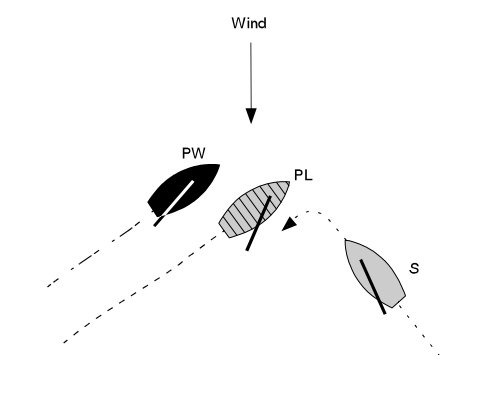(This is an instalment in a series of blogposts about the ISAF Case book 2009-2012 with amendments for 2011. All cases are official interpretations by the ISAF committees on how the Racing Rules of Sailing should be used or interpreted. The cases are copied from the Casebook, only the comments are written by me.)
Case 3
Rule 19.2(a), Room to Pass an Obstruction: Giving Room at an Obstruction
Rule 20.1, Room to Tack at an Obstruction: Hailing and Responding
Rule 64.1(c), Decisions: Penalties and Exoneration
A leeward port-tack boat, hailing for room to tack when faced with an oncoming starboard-tack boat, an obstruction, is not required to anticipate that the windward boat will fail to comply with her obligation to tack promptly or otherwise provide room.
Summary of the Facts
S hailed PL as the two dinghies approached each other on collision courses. PL then twice hailed ‘Room to tack’, but PW did not respond. PL, now unable to keep clear of S, hailed a third time, and PW then began to tack. At that moment, S, which was then within three feet (1 m) of PL, had to bear away sharply to avoid a collision. PW retired and S protested PL under rule 10. The protest committee disqualified PL observing that, not having had a timely response from PW, she should have used her right to luff and forced PW to tack.
PL appealed, claiming that:
- she had no right to force PW onto the opposite tack;
- even with both of them head to wind, S would still have had to change course to avoid a collision; and
- she had foreseen the development and had hailed PW in ample time.
Decision
PL’s appeal is upheld. PL is to be reinstated. Because S was an obstruction to PL and PW, PL was entitled to choose between tacking and bearing away (see rule 19.2(a)). Having decided to tack and having hailed for room to do so three times, PL was entitled by rule 20.1 to expect that PW would respond and give her room to tack. She was not obliged to anticipate PW’s failure to comply with rule 20.1. PL broke rule 10, but she is exonerated as the innocent victim of another boat’s breach of a rule, under the provisions of rule 64.1(c).
RYA 1962/37
We are almost at the ‘beginning’ of our Casebook. The Cases there, are all dealing with the most fundamental principles. In this particular case the right of the right-of-way boat to choose, and – if the keep clear boat does not do what it is suppose to do – the exoneration for breaking a rule.
But there’s another principle here;
Although most experienced regatta sailors know beforehand what is most likely going to happen, the rules don’t have any provisions or obligations that you have to anticipate. The rules deal in facts, not in intentions. In almost all incidents a boat has to act on the factual rights and obligations.
Am I keep clear boat?
Am I right of way boat?
And from the answers to those questions you know what you can or cannot do.
The trouble is that in any given situation the facts can change very quickly by what the boats do. That leads to ‘getting ahead’ of what the facts will become and with that to rights and obligations that are not (yet) established.
A port tacking boat will become a starboard right of way boat. But until it has completed its tack, it is still a keep clear boat. And until that time any (not tacking) boat does not have to respond, although its crew already knows that moment will come. If the tacking boat already acts as if she’s right of way boat, because that will happen in a second or two, it most likely will break rule 13.
The right-of-way boat in Case 3 does not have to anticipate that the keep clear boat will not act according to the rules – when she’s hailed three times.



What if PL tacks to avoid S, and breaks 13? There is an interesting discussion about case 3 vs. US appeals 2...
ReplyDeleteNow I can paste the link to the discussion (couldn't paste on the mobile version of blogger):
Deletehttp://www.unrulyracing.com/2010/11/isaf-case-3-and-versus-us-sailing.html
It was sent to me by another judge... we were discussing whether PL can be exonerated under 64.1(c) if, unlike PL in case 3, PL "forces PW to tack" by tacking to avoid S and breaking 13 against PW. This is related to our "compelled" discussion... US appeals 2 says no exoneration, case 3 says yes exoneration (but it cites "she had no right to force PW onto the opposite tack", maybe suggesting that if she attempted she might not be exonerated for the breach).
What is you take on this Jos? I can then tell you what our decision in that case was :)